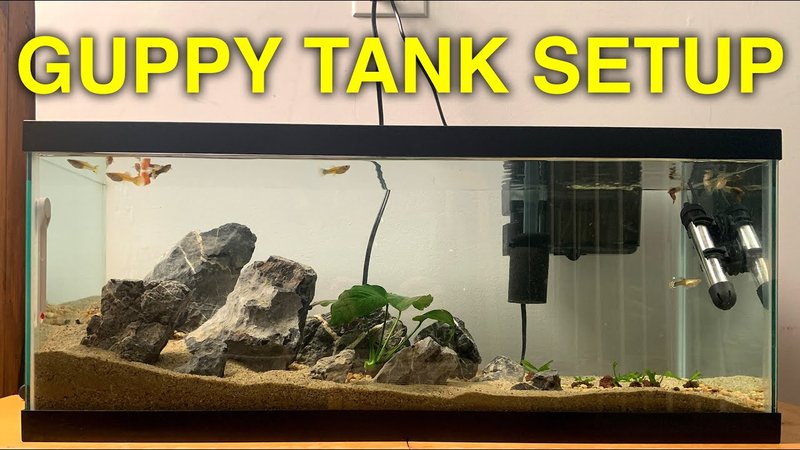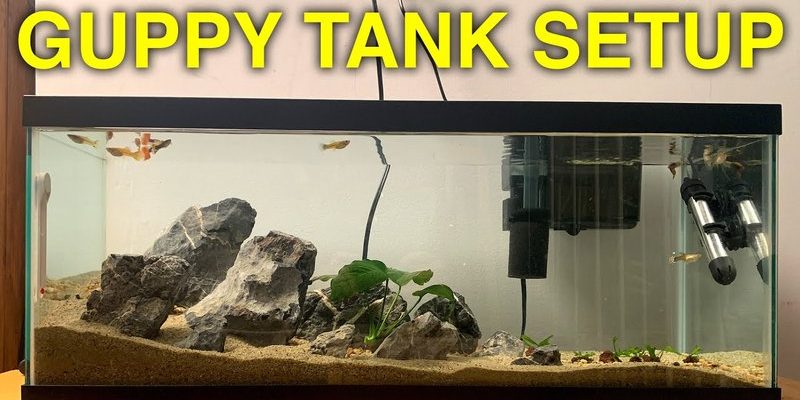
Guppies are vibrant, lively fish that can bring a splash of color and life to your aquarium. They’re often considered ideal pets for beginners due to their hardiness and adaptability. But don’t let that fool you; creating an ideal tank setup for guppies requires some thought and preparation. You’ll need to focus on tank size, water conditions, and decor to ensure your little swimmers thrive. Let’s break it down step by step!
Choosing the Right Tank Size for Guppies
When it comes to guppies, the tank size is crucial. You might be wondering, “How big should my tank be?” Well, here’s the scoop. For a small group of guppies (about five or so), a 10-gallon tank is a good starting point. This size provides ample swimming space and helps maintain stable water conditions.
Going larger can also be beneficial. If you opt for a 20-gallon tank, you’ll have more room for your guppies to roam and for adding plants and decorations. Plus, bigger tanks can help dilute waste more effectively, which keeps the water quality better. It’s a win-win!
Keep in mind that guppies are social creatures. They thrive in groups, so it’s best to keep at least three together to avoid loneliness. However, if you do choose a larger tank, you might consider adding more. Just make sure not to overcrowd it, as that can lead to poor water quality and stress among your fish.
Understanding Water Conditions: Temperature, pH, and Hardness
Next up, let’s talk water conditions. This is where things can get a little tricky. Guppies prefer a water temperature between 75°F and 82°F. Think of it like finding a comfortable room temperature; not too hot and not too cold. A reliable heater can help you maintain this temperature, especially in cooler months.
Water pH is another important factor. Guppies thrive in a pH range of 6.8 to 7.8. You can purchase a simple test kit to measure this. Keeping the pH stable is key, as sudden changes can stress your fish out. If you find your pH is off, there are plenty of ways to adjust it, like adding certain substrates or using water conditioners.
Hardness is often overlooked but is equally important. Guppies prefer soft to moderately hard water, with a hardness level between 5 and 20 dGH. Regular water changes (about 10-15% weekly) will help keep these levels in check and ensure your fish stay healthy.
Filtration: Keeping the Water Clean
You might be surprised at just how critical filtration is in a guppy tank setup. A good filter helps keep the water clean and maintains the right conditions for your guppies. There are several types of filters, but for guppies, a sponge filter or hang-on-back filter works well.
Sponge filters are gentle and provide excellent biological filtration. They’re an excellent choice for guppies, especially if you have fry (baby guppies) in the tank. Hang-on-back filters are also effective and can create a bit more water movement. Just remember that guppies don’t love strong currents, so make sure the filter flow isn’t too intense.
Regular maintenance is essential. Clean your filter as needed, but be careful not to disturb too much beneficial bacteria. It’s all about striking the right balance!
Creating the Perfect Décor for Guppies
Now onto the fun part—decor! Creating a visually appealing tank not only makes it look good but also provides a stimulating environment for your guppies. Live plants are a fantastic addition, as they provide hiding spots and help maintain water quality.
You can choose from a variety of plants like Java Fern, Anubias, or Hornwort. These plants are easy to care for and can thrive in the conditions your guppies need. They also help mimic a natural habitat, making your fish feel more at home.
Don’t forget about other decorations! Small rocks, driftwood, or aquarium-safe ornaments can add character and provide hiding spots. Just make sure anything you put in the tank is fish-safe and won’t leach harmful chemicals into the water.
Lighting: It’s More Important Than You Think
Lighting might seem like an afterthought, but it plays a significant role in your guppy’s tank setup. Proper lighting helps support plant growth and enhances the colors of your guppies. A good rule of thumb is to provide about 8 to 12 hours of light each day. A simple timer can make this easy!
Consider using LED lights, as they are energy-efficient and produce less heat. This type of lighting won’t raise the temperature of your water too much, which is a plus. Remember, just like us, fish need a day-night cycle. Giving them periods of darkness allows them to rest.
Regular Maintenance: Keeping Things in Check
Let’s talk about maintenance, which is key to your guppies staying healthy and happy. Regular water changes are the foundation of good tank care. Aim to replace about 10-15% of the water weekly. This helps remove harmful substances and keeps the water fresh.
You’ll also want to monitor your water parameters regularly. This includes temperature, pH, hardness, ammonia, nitrite, and nitrate levels. Keeping a log can help you track any changes over time, which can be super helpful for troubleshooting potential issues.
Don’t forget to clean the tank and decorations. Every month or so, give the tank a good scrub and remove any algae. Just be gentle and avoid disturbing your plants too much.
Adding Guppies to Your Setup: The Final Touch
Now that you have your tank all set up, it’s time to add your guppies! Start with a few at a time to avoid overwhelming the system. It’s a good idea to introduce them gradually and monitor the water quality after each addition to ensure everything runs smoothly.
When adding guppies, be mindful of their social structure. You’ll want a mix of males and females if you’re interested in breeding, but keeping more females than males can help minimize stress. The males can be quite the little charmers, and having a balanced gender ratio helps maintain harmony in the tank.
Once your guppies are in, sit back and enjoy! Watching them swim and interact is one of the most rewarding parts of having an aquarium. You’ll find yourself getting attached to their playful personalities.
In conclusion, setting up an ideal tank for guppies involves careful consideration of size, water conditions, decor, and maintenance. By following these guidelines, you’re not just creating a home for your fish—you’re building a vibrant ecosystem that can be both rewarding and educational. Happy fish-keeping!

